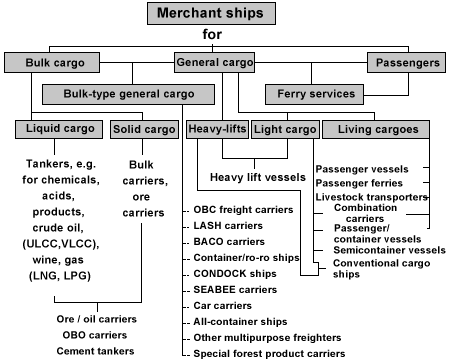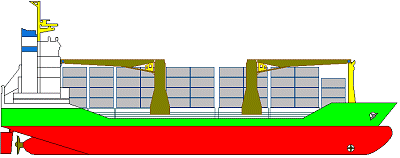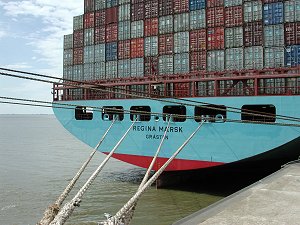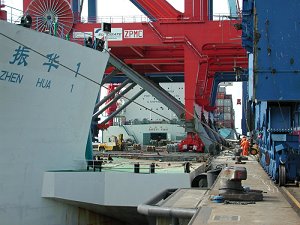Preface
Anyone using containers for maritime transport should have at least some kind of idea of what kinds of vessels are used for this purpose. When people who are not shipping professionals read press articles about gigantic new container ships, they find it hard to imagine that such ships could experience problems at sea. It is very often also forgotten that even containers which have been carried for the vast majority of their voyage on ultra-modern ships will have to be carried for the remainder of their voyage, quite possibly highly adventurously, on very different kinds of ships. This section of the Container Handbook is thus intended to provide a brief overview of the different kinds of ships which may be used to carry containers. Reference should be made to the appropriate specialist literature if detailed information is wanted or required.
Ships - general
Ships may be distinguished on the basis of various different criteria.For example, by
- type of propulsion;
- region of service;
- function;
- tonnage or measurement;
- arrangement of decks or superstructures etc.
Differentiation by region of service is often clear simply from the ship's name. Examples are lakers (for use on the Great Lakes and St. Lawrence Seaway), coasters (for coastal shipping), European inland waterway vessels, ocean-going vessels etc. For shipping professionals, the name is enough to give them a picture of the nature and appearance of the ship and how it accommodates cargo etc.
A ship's function is also generally reflected in its name, for example underwater vehicle, fishing vessel, tugboat, buoy-laying vessel, warship or the like. As their name would suggest, feeder ships, for example, carry goods for onward carriage by other ships.
Differentiation by tonnage, measurement, arrangement of superstructures etc. is generally only of interest to the specialist. Laypeople will be largely unconcerned whether goods are being carried on a full scantling, open-deck, shelter-deck or flush-deck vessel, a three-island or any other kind of vessel, although knowing the kind of vessel makes it possible to draw important conclusions about the type of carriage, transport risks, handling stresses etc.
The interested layperson should, however, be aware that gross or net register tonnages are not directly indicative of the size of a vessel, while the more recent terms gross and net tonnage are little more help.
Every shipper or charterer should know the term deadweight, which is the ship's payload in metric tons. And it certainly does no harm to know that the ship's displacement or displacement tonnage is its total weight, i.e. the sum of the weight of the empty, operational ship plus all permitted payload.
This section of the Container Handbook will now outline some essential distinguishing features of those merchant ships which carry containers and comparable "combined transport units". Press articles often refer to the "type of freight" in this connection, but strictly speaking this is incorrect as freight is the amount of money the shipowner or carrier receives for transporting the cargo.
Before taking a closer look at various types of ship, a breakdown by handling method may be helpful:
 |
Breakdown by handling method |
Lo/lo stands for lift-on/lift-off The cargo is lifted in and out of the ship (loaded and unloaded) using on-board lifting gear or loading gear, such as derricks, on-board cranes or gantries, or also on-shore lifting gear. This is the traditional handling method and is used for most ships throughout the world.
Ro/ro stands for roll-on/roll-off, meaning that the cargo is moved on and off the ship on wheels. This is achieved in various different ways. Loaded trucks drive on/off ship under their own power, the driver either traveling with the truck and continuing onward carriage or leaving the truck to continue its journey unaccompanied. In either case door-to-door transport is possible. The truck may travel unaccompanied when driven by a driver under contract. Door-to-door transport is again possible. Trailers or chassis are driven on board with special terminal tractors. Roll trailers are packed at the port of departure, hauled on board with special ro/ro tractors, hauled off at the port of destination and unpacked there. A similar situation applies to cassettes or container bolsters packed in port, which are lifted up with special terminal vehicles and rolled on board and back off again. This method covers all types of ship involved, for example, in ferry traffic. Containers and swap-bodies are here (virtually) exclusively embarked and disembarked on roll trailers, chassis and similar means.
Sto/ro stands for stow and roll. In this case, the cargo is rolled on or off ship using one of the above methods, but is conventionally stowed when on board, usually by means of forklift trucks. This method is not used for container traffic.
Flo/flo stands for float-on/float-off. Other variants are possible. Floating goods or goods loaded onto floating cargo carriers are floated in and out of dock-like holds in the ship. or Alternatively, the carrier vessel semisubmerges, moves under the cargo, refloats and lifts the cargo into the predetermined stowage space. The cargo is unloaded by performing the process in reverse. This method may be used for container transport if floating cargo carriers, such as barges, have already been loaded with containers.
In the truck-to-truck method, the cargo is set down using ground conveyors, such as forklift trucks, onto on-board lifts, raised/lowered to the appropriate loading level, where it is loaded using ground conveyors. Discharge proceeds in the reverse order. This method is not suitable for container traffic.
In the lift-and-roll method, the cargo is lifted on board with on-board loading gear or winch platforms and then rolled into place. This method is preferably used with a special type of barge carrier. This method is suitable for container traffic if the containers have previously been loaded onto or into the barges.
Wo/wo or walk-on/walk-off sounds comical, but is in fact the commonest handling method for livestock carriers. The animals walk onto and off the ship or into the containers or CTUs. The same principle applies to all passenger vessels.
A rough classification of ship type by kind of cargo carried could look as follows:
 |
|
Overview of merchant ship types |
The above list is not exhaustive, but does give a relatively good overview of common types of merchant vessel. In many ships, there is some overlap between the various options for carrying goods and the vessels cannot be assigned as strictly to one category or another as the list might suggest. There have always been many different kinds of vessel, but recent years have seen the introduction of many more. There is an unmistakable trend towards multipurpose ships. This makes it difficult to make general statements about what ships look like and how they are equipped.
Ships virtually always exhibit individual differences. Even sister and standard type vessels are not identical in every respect. In terms of naval architecture, there are no problems finding suitable vessels for cargo transport operations. Organizationally, however, it is more difficult to find the correct ship. It may be that certain vessels only serve specific ports or that certain cargoes can only be carried in ships of a particular nationality. One major issue is the increasing lack of skilled crews and stevedores in some parts of the world. In relation to container shipping, ro/ro and ferry traffic, packing and securing in and on cargo transport units is a significant problem. Non-seafarers underestimate the hazards of maritime transport and so for the most part pack and secure cargoes inadequately.
The following paragraphs contain some comments on a selection from the huge range of different ships which may be of interest to container importers and exporters. General cargo ships are only included to the extent that they also carry containers in many regions. For the most part, the many different kinds of vessels will be described only briefly.
At the beginnings of container traffic, most containers were carried on conventional general cargo vessels.
 |
|
| General cargo ship |
Such vessels are designed to carry dry cargoes. Each hold comprises one or more relatively low 'tween decks and a lower hold. The ships generally have a relatively large quantity of light cargo handling gear. Virtually every ship is equipped with appropriate loading gear for heavy-lift cargoes in the central hatch area. Lockers are provided for carrying particularly valuable cargoes. Some ships also have relatively small capacity sweet oil tanks.
General cargo ships of this old design are no longer being built, but many are still in use throughout the world. The seakeeping ability of most such vessels at sea, low stowage heights and the like generally mean that carriage is safe and loss-free if individual containers are located in favorable stowage spaces and carefully secured. Further information in this connection is provided in the shipping stresses section.
Modern general cargo ships are built to perform different transport functions; to distinguish them from other multipurpose freighters, they are sometimes known as break-bulk freighters. In addition to the equipment which makes them suitable for carrying break-bulk cargoes, they generally also have facilities to allow them to accommodate containers. Such ships are of open construction, i.e. the hatch area is very large relative to the deck area. This ensures that lifting gear can gain direct access to containers. The same applies to general cargo or access is at least facilitated to such an extent that below deck stowage can (very largely) be avoided. Specific construction features may increase handling efficiency in port and reduce the loss ratio.
 |
|
| Multipurpose container vessel |
Semi-container vessels are suitable for carrying both normal general cargo and containers. Hold dimensions, deck loading values, the load-carrying capacity of the loading gear etc. are tailored to the carriage of standard shipping containers. Such vessels have 'tween decks generally with flush-closing mechanical hatch covers.
 |
|
| Semi-container vessel |
All-container ships are in principle of open construction as it must be possible to gain direct access to each container with lifting gear such as top spreaders and similar gear. In order to obtain smooth, squared holds, these vessels are often constructed with a double hull. Any holds which are unsuitable for carrying containers are often fitted out as tanks. There are no 'tween decks. All-container ships primarily carry containers and are specially equipped for this purpose.
If the ports of the region of service are equipped with sufficiently powerful lifting gear, container ships are generally operated without loading gear. In other regions of service, container ships too need loading gear in the form of derricks, cranes or gantries.
Particular attention must be paid to the hydrodynamic design of container ships which operate at high cruising speeds. The tall, heavy deck loads cause problems with righting capacity. In order to ensure adequate stability, most all-container ships thus have to carry special solid or liquid ballast and/or be broader amidships. The capsize risk of the vessels can be kept within acceptable limits by high values of the roll moment of inertia. Large ballast capacities and high power pumps are absolutely essential, both for trimming the ships and for offsetting longitudinal bending moments. Shipbuilders can tailor characteristics by selecting appropriate ratios between length, beam, molded depth, draft and other dimensions.
The deadweight and hold capacity of container ships may also be stated in metric tons and cubic meters. The number of available slots for 20' or 40' containers, however, is more meaningful. TEU means "Twenty foot Equivalent Unit", while FEU means "Forty foot Equivalent Unit". More details are given in the section entitled "Container traffic terminology".
All-container ships are divided into generations depending upon their container capacity. Roughly speaking, the generations can be divided as follows:
| 1st Generation | up to | 1,000 | TEU |
| 2nd Generation | up to | 2,000 | TEU |
| 3rd Generation | up to | 3,000 | TEU |
| 4th Generation | more than | 3,000 | TEU |
| 5th Generation | more than | 6,000 | TEU |
| 6th Generation | more than | 8,000 | TEU |
 |
|
| Second generation container ship |
This Figure shows a second generation container ship. This is a Bremer Vulkan standard vessel which was built in various sizes over several generations. (BV 1000, BV 1600, BV 1800, BV 1800 S, BV 1900 and BV 2200, 2200 OH and BV 3800). The variant shown has on-board lifting gear.
 |
|
| Third generation container ship |
CTV "Bremen Express" is a third generation vessel and has a container capacity of 2,950 TEU, while CMV "Frankfurt Express", which was built in 1981, has a capacity of more than 3,400 TEU.
 |
|
| Fourth generation container ship |
One of the first fourth generation vessels, which have slots for more than 4,000 TEU, was put into service by American President Lines.
Hapag-Lloyd's Hannover Express class container ships, which were put into service in 1992, are similar to the American President Line vessels and were designed as Panamax ships. Technical data:
| Class: GL + 100 A 4 E + MC AUT "container ship" | ||
| Length overall | 294.00 | m |
| Length between perpendiculars | 281.60 | m |
| Molded beam | 32.25 | m |
| Depth to main deck | 21.40 | m |
| Design draft | 12.00 | m |
| Maximum draft | 13.52 | m |
| Deadweight, 12.00 m draft | 52,600 | metric tons |
| Deadweight, 13.52 m draft | 64,500 | metric tons |
| Cruising speed | 23 | kn |
| Cruising range | 24,000 | sm |
| Fuel consumption at 12 m draft and 23 kn | 138 | metric tons/day |
| as above with auxiliary diesel engines | 148 | metric tons/day |
| Container capacity on deck | 2,125 | TEU |
| Container capacity below deck | 2,282 | TEU |
| Total container capacity | 4,407 | TEU |
| Reefer connections on deck | 348 | units |
| Reefer connections below deck | 104 | units |
| Total reefer connections | 452 | units |
| Main engine: MAN B&W 9K 90 MC + TCS (Hyundai license) | ||
| Power output at 93 rpm | 36,500 | kW |
| Power output at 93 rpm | 49,640 | HP |
| Diesel generators, total of 4, of which 2 Daihatsu/Taiyo | 2,200 | kW |
| Diesel generators, total of 4, of which 2 Daihatsu/Taiyo | 1,650 | kW |
| Emergency diesel generator, one | 350 | kW |
| Total diesel generator power output | 8,050 | kW |
| Bow thruster, power output | 2,500 | kW |
| Bow thruster, thrust | 324,000 | kN |
| Heavy oil tank capacity | 7,360 | m³ |
| Diesel oil tank capacity | 360 | m³ |
| Ballast water tank capacity | 16,770 | m³ |
| Fresh water tank capacity | 280 | m³ |
Approx. 48.25% of the containers can thus be carried on deck and approx. 51.75% below deck. A special design makes it possible to carry up to eleven rows of containers below deck and up to thirteen rows on deck up to heights of ten tiers below deck and five tiers on deck. The forebody has twenty-nine bays available, while the afterbody has six. The versatility of the ships is enhanced by the possibility of lowering "flaps" in the guide system so that containers can be stopped at a certain height. Ordinary general cargo can be stowed in the resultant holds. This option is, however, also available in other ships. Hapag-Lloyd was the first to install the system on the "Humboldt-Express". In order, as required by regulations, to be able to transport hazardous cargo containers of certain classes below deck, five holds are specially fitted out for this purpose. Better segregation also makes it possible to increase the dangerous goods capacity in general relative to other ships.
There is a huge variety of different container ships in operation, as is shown, for example, by the ten new container vessels built in 1998 in Japan for the United Arab Shipping Company (UASC), Kuwait, each with a slot capacity of 3,802 TEU, 2,068 TEU of which, or 54.4% of the containers, can be carried in the hold.
| Vessel characteristics: | ||
| Length overall | 276.5 | m |
| Length between perpendiculars | 259.9 | m |
| Beam | 32.2 | m |
| Molded depth | 21.2 | m |
| Design draft | 12.5 | m |
| Propulsion | 34,348 | kW |
| Speed | 24.1 | kn |
When loading container vessels, the ship's command must comply with the maximum stacking load of the containers. This is especially important with the latest design of "hatchless" container ships. According to ISO minimum requirements, six fully loaded containers can be stacked one on top of the other. However, many containers are designed for a stack height of nine or more full containers.
In 1998, the first container ships with slot capacities of more than 6,000 TEU came into service. Examples are the "Karen Maersk", "Regina Maersk" and the Maersk shipping company's "Sovereign Maersk", which has a stated capacity of 6,600 TEU. With a length of 347 m, a beam of 42.8 m and a design draft of 14.50 m, it may be assumed that this vessel actually has a slot capacity of the order of 8,000 TEU.
 |
|
| Silhouette of a 5th generation container ship |
 |
Aftermost container bay on the "Regina Maersk " |
In the silhouette, the containers in the aftermost bay are stacked "only" five high, while in the photograph of the Regina Maersk it can be seen that they have been stacked as high as six high on deck. The Møller group shipping company currently known as Maersk-SeaLand is the world's largest container ship operator.
November 2001 saw the launch of what is, to date, Hapag-Lloyd's largest container ship, the "Hamburg-Express". With a length of 320 meters and a beam of 42.8 meters, seventeen containers can be stowed side by side across a single bay. Molded depth is 24.5 meters, which means that containers can be stacked nine high in the hold. When fully laden, the ship has a draft of 14.5 m.
The freighter can carry 7,500 standard containers (TEU) or 100,000 metric tons, a distinct increase over earlier vessels. Propulsion is provided by a 68,640 kilowatt marine diesel engine, corresponding to approx. 93,000 horsepower, which is capable of propelling these giant container vessels at a cruising speed in excess of 25 knots. Three further vessels in this series are to be delivered by spring 2003.
2002 itself saw the launch of what are to date the world's largest container ships of approx. 8,000 TEU.
Container ships of the future with lengths of approx. 400 m and a capacity of approx. 12,000-14,000 TEU are no longer purely in the realms of fantasy. Future generations of container ships with capacities of more than 15,000 TEU and lengths exceeding 400 m are already on the drawing board. These colossi will probably have beams of 64 m, and will require drafts of approx. 18 - 21 m. Such vessels would not at present be able to call at any European ports.
It remains to be seen whether such vessels can be operated economically. It is indisputable that transport costs per container or "slot costs" will drop in line with "economies of scale". A fundamental requirement for still larger ships is regular and continual growth in cargo volumes to be carried on the relevant routes. Such growth is also anticipated in coming years. However, it should not be forgotten that operating risks increase hand in hand with vessel size. Such still larger ships will have longer container handling times. In order to cut operating costs, the still larger vessels will have to lengthen their sailing intervals, i.e. they will call into fewer ports than the smaller vessels. As a result, more containers will have to be transported in precarriage and onward carriage operations to and from the ports which they do serve. Many other factors will also have to be taken into account, but these are outside the scope of this Container Handbook.
 |
Delivery of super post Panamax gantries to the Stromkaje at Bremerhaven. |
The North Sea Terminal Bremerhaven (NTB), for example, has already adjusted to the dimensions of future vessels. These "super post Panamax" container gantry cranes were installed as long ago as 2000 and are capable of handling vessels with up to twenty-two containers stowed side by side. With raised crane jibs, the gantries are more than 110 meters high and weigh approx. 1,600 metric tons.